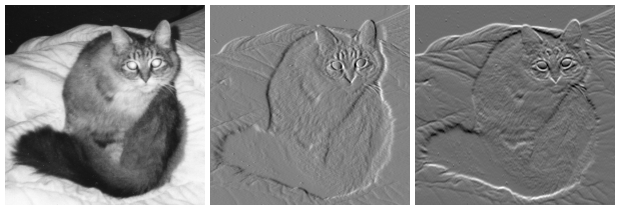Image gradient on:
[Wikipedia]
[Google]
[Amazon]

 An image gradient is a directional change in the intensity or color in an image. The gradient of the image is one of the fundamental building blocks in
An image gradient is a directional change in the intensity or color in an image. The gradient of the image is one of the fundamental building blocks in
 In
In
 An image gradient is a directional change in the intensity or color in an image. The gradient of the image is one of the fundamental building blocks in
An image gradient is a directional change in the intensity or color in an image. The gradient of the image is one of the fundamental building blocks in image processing
An image or picture is a visual representation. An image can be two-dimensional, such as a drawing, painting, or photograph, or three-dimensional, such as a carving or sculpture. Images may be displayed through other media, including a pr ...
. For example, the Canny edge detector uses image gradient for edge detection
Edge or EDGE may refer to:
Technology Computing
* Edge computing, a network load-balancing system
* Edge device, an entry point to a computer network
* Adobe Edge, a graphical development application
* Microsoft Edge, a web browser developed b ...
. In graphics software
In computer graphics, graphics software refers to a program or collection of programs that enable a person to manipulate images or models visually on a computer.
Computer graphics can be classified into two distinct categories: raster graphics ...
for digital image editing
Image editing encompasses the processes of altering images, whether they are Digital photography, digital photographs, traditional Photographic processing, photo-chemical photographs, or illustrations. Traditional analog image editing is known ...
, the term gradient or color gradient
In color science, a color gradient (also known as a color ramp or a color progression) specifies a range of position-dependent colors, usually used to fill a region.
In assigning colors to a set of values, a gradient is a continuous colormap, ...
is also used for a gradual blend of color
Color (or colour in English in the Commonwealth of Nations, Commonwealth English; American and British English spelling differences#-our, -or, see spelling differences) is the visual perception based on the electromagnetic spectrum. Though co ...
which can be considered as an even gradation from low to high values, and seen from black to white in the images to the right. Another name for this is ''color progression''.
Mathematically, the gradient
In vector calculus, the gradient of a scalar-valued differentiable function f of several variables is the vector field (or vector-valued function) \nabla f whose value at a point p gives the direction and the rate of fastest increase. The g ...
of a two-variable function (here the image intensity function) at each image point is a 2D vector
Vector most often refers to:
* Euclidean vector, a quantity with a magnitude and a direction
* Disease vector, an agent that carries and transmits an infectious pathogen into another living organism
Vector may also refer to:
Mathematics a ...
with the components given by the derivative
In mathematics, the derivative is a fundamental tool that quantifies the sensitivity to change of a function's output with respect to its input. The derivative of a function of a single variable at a chosen input value, when it exists, is t ...
s in the horizontal and vertical directions. At each image point, the gradient vector points in the direction of largest possible intensity increase, and the length of the gradient vector corresponds to the rate of change in that direction.
Since the intensity function of a digital image is only known at discrete points, derivatives of this function cannot be defined unless we assume that there is an underlying continuous
Continuity or continuous may refer to:
Mathematics
* Continuity (mathematics), the opposing concept to discreteness; common examples include
** Continuous probability distribution or random variable in probability and statistics
** Continuous ...
intensity function which has been sampled at the image points. With some additional assumptions, the derivative of the continuous intensity function can be computed as a function on the sampled intensity function, i.e., the digital image. Approximations of these derivative functions can be defined at varying degrees of accuracy. The most common way to approximate the image gradient is to convolve an image with a kernel, such as the Sobel operator or Prewitt operator.
Image gradients are often utilized in map
A map is a symbolic depiction of interrelationships, commonly spatial, between things within a space. A map may be annotated with text and graphics. Like any graphic, a map may be fixed to paper or other durable media, or may be displayed on ...
s and other visual representations of data
Data ( , ) are a collection of discrete or continuous values that convey information, describing the quantity, quality, fact, statistics, other basic units of meaning, or simply sequences of symbols that may be further interpreted for ...
in order to convey additional information. GIS tools use color progressions to indicate elevation
The elevation of a geographic location (geography), ''location'' is its height above or below a fixed reference point, most commonly a reference geoid, a mathematical model of the Earth's sea level as an equipotential gravitational equipotenti ...
and population density
Population density (in agriculture: Standing stock (disambiguation), standing stock or plant density) is a measurement of population per unit land area. It is mostly applied to humans, but sometimes to other living organisms too. It is a key geog ...
, among others.
Computer vision
 In
In computer vision
Computer vision tasks include methods for image sensor, acquiring, Image processing, processing, Image analysis, analyzing, and understanding digital images, and extraction of high-dimensional data from the real world in order to produce numerical ...
, image gradients can be used to extract information from images. Gradient images are created from the original image (generally by convolving with a filter, one of the simplest being the Sobel filter) for this purpose. Each pixel of a gradient image measures the change in intensity of that same point in the original image, in a given direction. To get the full range of direction, gradient images in the x and y directions are computed.
One of the most common uses is in edge detection. After gradient images have been computed, pixels with large gradient values become possible edge pixels. The pixels with the largest gradient values in the direction of the gradient become edge pixels, and edges may be traced in the direction perpendicular to the gradient direction. One example of an edge detection algorithm that uses gradients is the Canny edge detector.
Image gradients can also be used for robust feature and texture matching. Different lighting or camera properties can cause two images of the same scene to have drastically different pixel values. This can cause matching algorithms to fail to match very similar or identical features. One way to solve this is to compute texture or feature signatures based on gradient images computed from the original images. These gradients are less susceptible to lighting and camera changes, so matching errors are reduced.
Mathematics
The gradient of an image is a vector of its partials: :, where: : is the derivative with respect to x (gradient in the x direction) : is the derivative with respect to y (gradient in the y direction). Thederivative
In mathematics, the derivative is a fundamental tool that quantifies the sensitivity to change of a function's output with respect to its input. The derivative of a function of a single variable at a chosen input value, when it exists, is t ...
of an image can be approximated by finite differences
A finite difference is a mathematical expression of the form . Finite differences (or the associated difference quotients) are often used as approximations of derivatives, such as in numerical differentiation.
The difference operator, commonly d ...
. If central difference is used, to calculate we can apply a 1-dimensional filter to the image by convolution
In mathematics (in particular, functional analysis), convolution is a operation (mathematics), mathematical operation on two function (mathematics), functions f and g that produces a third function f*g, as the integral of the product of the two ...
:
:
where denotes the 1-dimensional convolution operation. This 2×1 filter will shift the image by half a pixel. To avoid this, the following 3×1 filter
:
can be used. The gradient direction can be calculated by the formula:
: